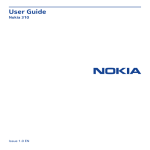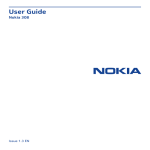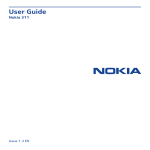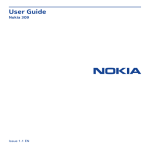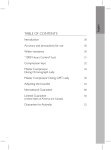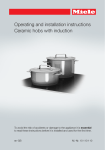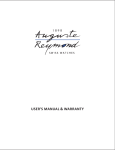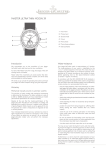Download Product Manual In PDF
Transcript
Oris SA Ribigasse 1 CH-4434 Hölstein Phone +41 61 956 11 11 Fax +41 61 951 20 65 [email protected] www.oris.ch Product Manual Introduction . . . . . . . . . . . . . . . . . . . . . . . . . . . . 9 Starting Oris watches . . . . . . . . . . . . . . . . . . . . 10 Crown positions . . . . . . . . . . . . . . . . . . . . . . . . 10 Standard crown . . . . . . . . . . . . . . . . . . . . . . . . 10 Screw-down crown . . . . . . . . . . . . . . . . . . . . . . 10 Crown with Oris Quick Lock system (QLC) . . . . . 10 Screw-down pushers . . . . . . . . . . . . . . . . . . . . 10 Automatic winding watches . . . . . . . . . . . . . . . 11 Manual winding watches . . . . . . . . . . . . . . . . . 11 Setting and operating Oris watches . . . . . . . . . . 12 Date, day of the week and time . . . . . . . . . . . . 12 Setting the date . . . . . . . . . . . . . . . . . . . . . . . 12 Worldtimer . . . . . . . . . . . . . . . . . . . . . . . . . . . 12 Worldtimer with 3rd time zone and compass . . . 13 2nd time zone on outer rotating bezel . . . . . . . . 14 2nd time zone indicator on inner rotating bezel with vertical crown . . . . . . . . . . . . . . . . . 14 2nd time zone with additional 24 hr hand . . . . . 14 2nd time zone with additional 24 hr hand and city markers on the rotating bezel . . . . . . . . . . 14 Chronograph . . . . . . . . . . . . . . . . . . . . . . . . . 15 Complication . . . . . . . . . . . . . . . . . . . . . . . . . 15 Regulator . . . . . . . . . . . . . . . . . . . . . . . . . . . . 16 Pointer calendar . . . . . . . . . . . . . . . . . . . . . . . 16 Alarm with automatic winding . . . . . . . . . . . . . 16 Tachymeter scale – measuring speeds . . . . . . . 17 Telemeter scale – measuring distances . . . . . . 17 Rotating bezel for diving watches with a 60 minute graduation . . . . . . . . . . . . . . . . . . 18 Helium valve . . . . . . . . . . . . . . . . . . . . . . . . . . 18 Watch as a compass . . . . . . . . . . . . . . . . . . . . 18 7 Adjusting Oris watches to fit the wrist . . . . . . . . 20 Watches with leather straps . . . . . . . . . . . . . . 20 Watches with rubber straps . . . . . . . . . . . . . . . 20 Watches with metal bracelets . . . . . . . . . . . . . 20 Fine adjustment of folding clasps . . . . . . . . . . . 20 Notes . . . . . . . . . . . . . . . . . . . . . . . . . . . . . . . . 22 Accuracy . . . . . . . . . . . . . . . . . . . . . . . . . . . . 22 Chronometer . . . . . . . . . . . . . . . . . . . . . . . . . 22 Water-resistance . . . . . . . . . . . . . . . . . . . . . . . 24 Use and maintenance . . . . . . . . . . . . . . . . . . . 24 Technical information and summary tables . . . . . . . . . . . . . . . . . . . . . . . . 26 Pictograms . . . . . . . . . . . . . . . . . . . . . . . . . . . 26 Metals for cases and straps . . . . . . . . . . . . . . 27 PVD coatings . . . . . . . . . . . . . . . . . . . . . . . . . 27 Sapphire crystal . . . . . . . . . . . . . . . . . . . . . . . 27 Mineral glass . . . . . . . . . . . . . . . . . . . . . . . . . 28 Plexi glass . . . . . . . . . . . . . . . . . . . . . . . . . . . 28 Luminescent dials and hands . . . . . . . . . . . . . 28 Metal bracelets, leather and rubber straps . . . . 28 Lunar calendar . . . . . . . . . . . . . . . . . . . . . . . . 29 Time zones . . . . . . . . . . . . . . . . . . . . . . . . . . 30 Movements . . . . . . . . . . . . . . . . . . . . . . . . . . 30 International guarantee for Oris watches . . . . . . 32 Proof of ownership . . . . . . . . . . . . . . . . . . . . . . 33 Subject to modifications. English Contents. 9 We congratulate you on the purchase of your new Oris watch and extend a warm welcome to the ranks of mechanical watch devotees. You see, Oris’ world is all about mechanics, and nothing but mechanics. Your Oris watch sets itself firmly apart from mass market and fashion products, and instead embodies the true values of the Swiss art of watchmaking, with its fascinating micro-mechanical internal components and its stylishly seamless exterior. Oris watches not only inherit a long tradition dating back to 1904, but also all incorporate a refined ‘High-Mech’ system, imbued with the craftsmanship of our watchmakers and co-developed by well-known professionals from the worlds of Formula One, diving and aviation. Please visit our site at www.oris.ch for further information and for a free extended guarantee period when you sign up to the exclusive Oris members club: MyOris. We wish you quality time with your Oris. Ulrich W. Herzog Executive Chairman Another very important feature in our modern times: Oris watches do not require any batteries because you supply your Oris watch with power via your own movements, or by winding it manually. Explanation of instruction arrows: = Operating instructions = Useful information English Introduction. 11 Standard crown. The positions described below are valid in most cases. Any deviations will be mentioned for the relevant type of movement. Oris standard crowns are highprecision components. They are equipped with seals to prevent any water penetration. About half of Oris watches are equipped with this kind of standard crown. 0 Crown positions. | Pos. 0 Crown locked, for screw-down crowns and for crowns with Oris Quick Lock system The crown is in position 1 and can be operated immediately, as described in the following chapters. 2 0 Screw-down crown. | Pos. 1 Winding position 2 0 | Pos. 2 Date and day of the week setting 2 0 | Pos. 3 Setting the time 2 None of the following operations must be performed in water. Crown with Oris Quick Lock system (QLC). B A few Oris watches, especially the divers’ watches, are equipped with a screw-down crown. Before you can operate a crown of this kind, it must first be unscrewed. Turn the crown anti-clockwise until it is released from its thread. Now the crown is in position 1 and can be operated as described in the following chapters. After the setting, the crown must be tightened back down by pressing it against the case while turning it clockwise. Check from time to time to ensure that the crown is properly screwed down. The watch is only water-resistant to its specified depth if the crown has been screwed down. r The Quick Lock Crown (QLC) developed by Oris is simpler to release than the screw-down crown because it has a bayonet fastening instead of a thread. Press the crown gently against the case and turn it slightly anti-clockwise until the crown releases. Now the crown is in position 1 and can be operated as described in the following chapters. After the setting, the crown must be relocked by pressing it against the case and, at the same time while turning it slightly clockwise until it locks in position. The watch is only water-resistant to its specified depth if the crown has been locked. Screw-down pusher. ? Some Oris models, especially diving watches, have screw-down pushers as well as screw-down crowns. Turn the crown which encloses the pusher anti-clockwise until you encounter resistance. Now the pusher can be operated, as described in the following chapters. After the setting, press the crown gently against the case and turn it clockwise until you encounter resistance. The watch is only water-resistant to its specified depth if the pusher has been screwed down. pushers must never be operated underwater. Automatic winding movement. a An Oris watch that has started and is worn daily for about 12 hours, does not need manual winding. Instead, arm movements cause the red rotor to rotate, thereby tightening the barrel spring. Even if you take off your watch at night, it continues to run. It only stops working if it is not worn for approx. 40 hours. If an automatic winding watch stops, it must be restarted as follows: Release the screw-down crown or QLC crown (if fitted) as per the instructions in chapter 1. With the crown in position 1, rotate it clockwise through 12 turns (it can also be turned forwards and backwards). Carry out the settings, as described below. Lock the screw-down crown or QLC crown (if fitted) as per the instructions in chapter 1. On the crystal case-back of certain Oris automatic winding watches, you can see how the red rotor, the hallmark of Oris watches, rotates and winds the movement. Manual winding movement. A On mechanical Oris watches with manual winding, the barrel spring is wound by hand. The power reserve of a fully wound watch is approximately 42 hours. Release the screw-down crown or QLC crown (if fitted) as per the instructions in chapter 1. Turn the crown clockwise in position 1. It can also be turned forwards and backwards. Stop as soon as you encounter resistance. The barrel spring is now fully wound. If more force is applied after the spring is fully wound, there is a risk of the end of the spring breaking. In such cases, the barrel needs to be replaced at the watch owner’s expense. Wind the watch once a day. Lock the screw-down crown or QLC crown (if fitted) as per the instructions in chapter 1. English Starting Oris watches. 6 7 9 28 8 3 It takes about 10 minutes until T1 and T2 start running simultaneously. The tolerance can be up to one minute. 0 10 7 4 2 10 24 9 1 4 7 0 120 8 9 T3 T1 28 3 210 5 6 5 E 6 10 2 S Release the screw-down crown or QLC crown (if fitted) as per the instructions in chapter 1. Pull out the crown to position 2. Depending on the movement type, turn the crown clockwise or anticlockwise and then set to the desired date. Press the crown into position 1. Lock the screw-down crown or QLC crown (if fitted) as per the instructions in chapter 1. T2 4 5 8 Pull out the crown again to position 3 and set the current time, completing another full turn of the dial for an afternoon time. The watch is stopped in this position and can be restarted at any time, by pressing the crown into position 1. Press the crown into position 1. Lock the screw-down crown or QLC crown (if fitted) as per the instructions in chapter 1. 60 5 1 4 30 Pos. 3 (fig. 1) 0 After months with fewer than 31 days, the date must be set forward manually to the first day of the following month via rapid correction (crown in position 2). 28 15 Release the screw-down crown or QLC crown (if fitted) as per the instructions in chapter 1. Pull out the crown to position 3. Turn the hands forward until the date changes, and 05:00 the next day is indicated. The rapid date and day corrections cannot be performed between 21:00 and 03:00 because the mechanism is meshed for the change and damage may occur. Pos. 2 12 Pos. 1 N Setting the date. Pos. 0 Crown Crown locked with screw-down crown or crown with Oris Quick Lock system (QLC) Winding position Setting the date Setting the time T1 (local time) T2 (home time) Small second Day/night indicator Date – pusher for T1 + pusher for T1 C As well as the functions described in the previous ‘Oris Worldtimer’ chapter, this watch has a separately adjustable inner rotating bezel for an additional time zone, and the cardinal points of a compass. This watch is ideal for people who need a constant display of 3 time zones, e.g. pilots, frequent flyers, international business people, etc. 11 locked, for screw-down crowns and for crowns with Oris Quick Lock system Pos. 1 Winding position Pos. 2 Date and day of the week setting Pos. 3 Setting the time Pos. 0 Worldtimer with 3rd time zone and compass. 0 33 3 4 5 6 7 8 The date can be corrected forwards or backwards (Oris patent filed) if setting the time with the + or – pusher and passing midnight. 10 2 The Oris Worldtimer has two separate time zone displays: T1 local time and T2 home time. Both displays have their own hour and minute hands. The minute hands of T1 and T2 run simultaneously. The hour hand on T1 can be adjusted forward or backward an hour at a time or very rapidly by pressing the two pushers. In rapid adjustment, the date can be moved forward or backward between 23:00 and 03:00 (Oris patent filed). T2 also has a day/night indicator. Setting T1 (local time): Press the + or – pusher once for each hour’s difference from T2 (home time). Synchronising times, setting the time and date: Release the screw-down crown or QLC crown (if fitted) as per the instructions in chapter 1. Pull out the crown to position 3, turn it anti-clockwise and set T2 to 05:00. The day/night display appears dark. Using the + pusher, set T1 to 05:00 too, i.e. the date must change between 01:00 and 03:00. Press the crown into position 2, turn it anti-clockwise and set the date. Turn the desired date slightly further than the window aperture (see fig. 1) until a slight click is heard. Then turn the crown slightly clockwise to centre the date in the window. 300 1 C 9 0 Worldtimer. W This instruction applies to most movements produced for Oris watches, with date and day of the week window display or date and day of the week hand indicators. Exceptions such as the Oris Complication or Oris Chronograph (movement 676) are described in the sections for the corresponding types of movement. Push the crown back into position 2. Depending on the movement type, turn the crown clockwise or anti-clockwise and then set the current date. If a day of the week display is provided, turn the crown anti-clockwise and set the day. Pull out the crown to position 3. Set the time – completing another full turn of the dial for an afternoon time. The watch is stopped in this position and can for example be restarted at a time signal, by pressing the crown into position 1. Press the crown into position 1. Lock the screw-down crown or QLC crown (if fitted) as per the instructions in chapter 1. T1 T2 T3 7 9 10 Compass graduation Small second Day/night display Date – pusher T1 + pusher T1 Vertical crown for setting of T3 and compass On the figure above T1 indicates 06:53 or 18:53 T2 02:53 T3 09:53 or 21:53 Synchronising T1 and T2, setting the time and date: Proceed as described in ‘Worldtimer’ chapter. Setting T3: Determine T3 i.e. the time at destination and/or time difference from departure location. Pull the vertical crown (10) upwards. Turn the vertical crown (10) clockwise or anti-clockwise and set the corresponding + or – time difference, i.e. that between 12:00 in T3 (time at destination) and 12:00 in T1 (time at starting point). Press the vertical crown downwards to the neutral position. 8 Date, day of the week and time. 13 6 Time at starting location Home time or GMT Time at destination location Setting the compass: Remove watch from wrist. Pull the vertical crown upwards and set south on the compass rotating bezel on the bisector (i.e. mid-point) between the hour hand and 12 o’clock. (Between 18.00 English Setting and operating Oris watches. 7 1 5 6 12 28 2 4 3 21 3 3 12 | 24 | 2 T2 (e.g. home time) | | 4 20 | | 22 18 | | 6 28 0 8 16 Pull the vertical crown (1) upwards. Turn the crown clockwise or anticlockwise and set the desired 2nd time (T2). Press the vertical crown downwards to the neutral position. | | 9 8 2nd time zone indicator on inner rotating bezel with vertical crown. 14 | 7 In the above example, the 2nd time zone shows 08:53 or 20:53. Release the screw-down crown or QLC crown (if fitted) as per the instructions in chapter 1. Pull out the crown to position 2, turn it anti-clockwise and set the desired time for T2 (e.g. home time). Press the crown into position 1. Lock the screw-down crown or QLC crown (if fitted) as per the instructions in chapter 1. 12 | 6 10 5 11 4 2nd time zone with additional 24 hr hand. 10 1 2 3 Example: Local time in London (GMT) is 13:20. The 24 hour hand points to 21:00, home time in Hong Kong. The rotating bezel was adjusted so that the 24 hour hand displays Hong Kong as the home city. The time in the cities listed 2 8 4 9 3 7 9 O IR MO 7 28 6 5 0 1 2 3 LONDO IA EORG N S. G . AZORES PAR D. J IS C A AS IO | AC R | | 2 3 In the figure above, T1 indicates 06:53 or 18:53 and T2 to 03:53 or 15:53 10 15 2nd time zone on outer rotating bezel. Release the screw-down crown or QLC crown (if fitted) as per the instructions in chapter 1. Pull out the crown to position 2, turn it clockwise and set the desired time for T2 (e.g. home time). Press the crown into position 1. Lock the screw-down crown or QLC crown (if fitted) as per the instructions in chapter 1. Turn the outer bezel with the city marker until the time in the desired city (home city) matches T2 (24 hour hand). Times in the cities listed on the rotating bezel can now be read off. This setting does not take into account daylight saving time. To read off the time in these cities on the rotating bezel again, assuming that T2 is showing ‘home time’, always align ‘home city’ on the rotating bezel with the T2 hand (updated). 24 hour hand (T2) AUCK NE Y SYD NOUMEA LAND MID WA HA NG KYO Y KO TO 1 23 | | | 12 11 1 17 Vertical crown T1 (local time) T2 on inner rotating bezel (e.g. home time) 1 3 1 » ES MEX NGELDENVER ICO CIT Y L. A NEW YO CAR EAU I AI N | RK 5 W JU | | 2nd time zone with additional 24 hr hand and city markers on the rotating bezel. on the rotating bezel can now be read off. New York 08:20, Cairo 15:20, Moscow 16:20, etc. This setting does not take into account daylight saving time. DH AI DUB KARACHI AKA BAN H OW G K ON SC OK G | 19 | | 10 2 2 Turn the rotating bezel to the desired 2nd time zone In the above example, it is 11:53 in the 2nd time zone. 1 9 8 11 and 06.00, take the bigger angle between the hour hand and 12 o’clock.) Press the vertical crown downwards to the neutral position. Align the hour hand with the sun and read off the cardinal points on the compass bezel. See figure in the chapter ‘Watch as a Compass’. 15 13 11 Chronograph. The Oris chronograph has a stop watch function as well as a time and date display. This is a very useful function for everyday use. Crown and pusher operation, see chapter: ‘Starting the watch’ Time and date setting, see chapter: ‘Operating Oris watches’ (exception: date setting on movement 676 – see below). stops the chronograph hand once again and freezes timing. Press pusher 5 – the stopped chronograph hand and the minute and hour counters are reset to their starting positions. 8 9 10 Reading chronograph timing: With the chronograph second hand (7), the elapsed time can be read on the dial scale, between 1/4 second and 60 seconds maximum. With the chronograph minute hand (8), you can read the elapsed minutes, up to 30 minutes maximum. With the chronograph hour hand (9), you can read the elapsed halfhours and hours, up to 12 hours maximum. 8 7 4 6 28 0 1 2 3 5 10 Stop timer and reset all chronograph indicators to their starting positions: Press pusher 4 – the chronograph hand starts running Press pusher 4 again – this stops the chronograph hand and freezes timing. Press pusher 4 again – the chronograph hand restarts running from the previous stop point. Press pusher 4 once again – this 7 9 Pos. 0 Pos. 1 Pos. 2 Pos. 3 4 5 6 Crown locked, for screw-down crown or QLC crown Winding position Date setting Time setting Start and stop pusher Reset pusher Vertical pusher for setting date on movement 676 Press the pusher in using an appropriate tool or a wooden toothpick to set the date Chronograph second hand Chronograph minute hand Chronograph hour hand Second hand for normal time display, running constantly On some models, the second hand is deliberately omitted. In this case, the chronograph second hand (7) can be left in motion permanently, for use as a second hand for normal time display. Complication. Release the screw-down crown or QLC crown (if fitted) as per the instructions in chapter 1. Pull out the crown to position 2. Turn the hand forwards. The moon phase indicator moves its position 1/28th of a month right between 22:00 and 23:00. One day before the current moon position is reached, take account of the date change, then set the time to 05:00. Press pusher 3 with the special tool provided, or with a wooden toothpick, until the desired date is set. Press pusher 4 and set the day of the week. Set the current time with the crown – completing another full turn of the dial for an afternoon time. English Setting and operating Oris watches. 17 UE · SA 8 · 16 · · 6 12 10 Crown operation, time and date setting as per instructions in chapter 1. U · W ED 0 1 2 5 7 8 ND 4 5 3 27 2 26 NE SDA Y THU RS Y DA 8 ED 24 25 W 9 10 Crown B, Pos. 2 Crown A: Movement winding, time and date setting as per instructions in chapter 1. 11 Turn crown B clockwise to position 1 and, if necessary, tighten alarm movement (e.g. if used several times a day, or if the watch is being restarted) by turning the crown 12 times. In normal use of an automatic winding alarm, the movement and alarm springs are constantly wound. Pull out crown B to position 2, turn it anti-clockwise and set the desired alarm time. In this crown position, the alarm function is enabled, and the alarm will sound at the set time within the next 12 hours. Press crown B into position 1. The alarm function is disabled. 19 18 17 16 15 14 13 12 Crown A Alarm with automatic winding. « 1 Crown B 1 2 300 275 250 28 80 225 85 200 190 180 170 160 90 150 100 110 120 130 5 140 Tachymeter scale – Measuring speeds. The tachymeter scale on the ring or dial of the Oris chronograph is used to measure speed, e.g. of a car travelling a measured distance of 1 km (or 1 mile). If a rotating tachymeter ring is fitted, position the 60 of the tachymeter to 12 o’clock. Start the chronograph function by pressing pusher 4 as soon as the vehicle passes the start line. Press pusher 4 again as soon as the vehicle crosses the finish line. The chronograph hand will indicate the average speed in km (or miles) per hour on the tachymeter. In the following example, the vehicle required 40 seconds to cover the measured distance, which equates to an average speed of 90 km/h (or 90 mph). Average speeds of less than 60 km/h (60 mph) cannot be measured. Press pusher 5 to reset all the counters. Telemeter scale – Measuring distances. The telemeter scale on the ring or dial of Oris chronographs is used to measure the distance between an immediately visible and subsequently audible event (thunder and lightning, burst and sound from fireworks, etc.). The graduation on this telemeter scale is based on the speed of sound, i.e. 343 m/s in air at 20 °C. With a rotating telemeter ring, position the zero to 12:00. ELEMETER 1 KM 19 T 2 18 4 28 5 28 400 350 13 In 1988, the first Oris alarm watch with manual winding appeared on the market. The alarm watch launched in 2008 has a movement with automatic winding. It is cha- 3 2 4 500 75 4 7 1 Crown B, Pos. 1 ME TE R 3 6 30 31 Crown A, Pos. 3 60 TACH Y 65 70 14 Setting the 2nd time zone This setting can be made at any time. Press pusher 5 (2nd time zone) with the special tool provided, or with a wooden toothpick, and set the desired time. 29 7 Pos. 3 28 6 Pos. 2 28 5 Pos. 1 Crown locked, for screw-down crowns and for crowns with Oris Quick Lock system Winding position Date and day of the week setting Time setting Second hand Minute hand Hour hand Date indicator 4 Pos. 0 20 9 7 21 8 6 5 SA T 22 7 SUNDAY AY 23 6 3 F RI D A Y 5 2 Y DA 4 1 28 UR 3 0 4 MO Pos. 2 Crown operation, time and date setting as per instructions in chapter 1. ESDAY Pos. 1 Crown locked, for screw-down crown or QLC crown Winding position Time and moon phase setting pusher for date setting pusher for day of the week setting pusher for 2nd time zone indicator setting Date indicator Day of the week indicator 2nd time zone indicator Moon phase indicator TU Pos. 0 Crown A, Pos. 2 movement spring winding position date setting time setting alarm spring winding position, Alarm not activated alarm time setting, alarm activated 6 · · · · 18 · 20 ·6· · ·4 · · 24 · 2 ·T 7 · ·25 ·2 9 · · 11 · 22 14 · FRI 23 21 ·7· · TH 17 15 13 SUN · M ON ·5 19 T· Crown A, Pos. 1 7 4 29· 31 1 · 3 The launch of the first Oris movement with pointer calendar in 1938 was a milestone in company history. The Oris Pointer offers the advantage of indicating not only the time or day of the week spatially on the relevant scale on the dial. Since the introduction of this typical Oris movement, various models with this type of indicator have been made. Naturally, the movement has changed several times since its introduction to meet the latest technological requirements. racterised by a special alarm chime created by a sound spring. This product is perpetuating a long tradition, and one which reached a high point with the Oris alarm clock with 8-day movement back in 1949. 17 Originally, the regulator was an extremely accurate clock which was used to test and adjust (set) small clocks. To prevent the hands from overlapping, they were separated. On a regulator, only the minute hand turns in the centre, whereas the seconds and hour are indicated in small separate sub-dials. 9 3 Pointer calendar. 16 Regulator. 15 The watch is stopped in this position and can be restarted at any time, by pressing the crown into position 1. Press the crown into position 1. Lock the screw-down crown or QLC crown (if fitted) as per the instructions in chapter 1. 12 8 11 10 9 5 English Setting and operating Oris watches. 0 Watches with a helium valve are intended for divers who spend extended periods on board a diving bell, or in any other chamber with a helium-enriched atmosphere. The inert gas helium has one of the smallest molecules, meaning that it can penetrate the seals on watches and enter the case. Once inside the case, this gas is unable to escape rapidly enough unless a special valve is fitted, i.e. the helium valve. Opening this valve Watches with an analogue hour and minute display can be used as compass, using the position of the sun as a guide. This depends on the sun’s position being clearly visible, and on the watch showing the correct time. If the watch has a graduated bezel, this can be used to find the bisector (mid-point). Remove the watch from your wrist and turn it until the hour hand is pointing at the sun. Determine the bisector (mid-point) between the hour hand and 12 o’clock. (Between 18.00 and 1 E 10 2 8 4 60 9 3 30 30 | 20 | Watch as a compass. Helium valve. S 12 11 7 5 6 N Even if the valve remains open, the watch would still be water-resistant for normal purposes. But for diving operations of any kind, the valve must be closed, as described above. x 150 120 330 10 Rotating bezel for measuring time to the nearest hour: Position the marker on the rotating bezel opposite the hour hand, or to the desired hour end position. The hours elapsed, or the hours past the preset end time can be read on the bezel. Before leaving the diving station, turn the crown on the helium valve anti-clockwise as far as it will go (to open). S x 300 | In the above example, 33 minutes have elapsed since the start of measurement. W Rotating bezel for measuring time to the nearest minute: Position the marker on the rotating bezel opposite the current minute hand position, or to the desired minute hand end position. The minutes elapsed, or the minutes past the preset end time can be read on the bezel. Before a dive, turn the helium valve crown clockwise to its limit stop and close the valve. 28 06.00, take the bigger angle between the hour hand and 12 o’clock.) This equates to South. Once you have established where South lies, the other cardinal points can be extrapolated from that. 240 The rotating bezel on a diving watch can also be used as a timer or for any kind of time indication to the nearest minute or hour, e.g. parking, cooking, game time, etc. prevents any excess pressure on the watch glass from inside after the ascent. The helium valve is identified on Oris diving watches by a coloured spot on the crown. | 210 The rotating bezel on all Oris diving watches can only be adjusted in an anti-clockwise direction. This prevents the measured or set time from being extended if the bezel is turned accidentally. This ensures that the diver has enough time left to decompress properly. 40 | Rotating bezel for diving watches with a 60 minute graduation. | 50 Start the chronograph function using pusher 4 as soon as a visible event occurs. Press pusher 4 again as soon as you hear the sound. In the above example, the thunderstorm is still at a distance of 3 kilometres. 19 If the watch has a rotating bezel with compass graduation, it is easier to identify all the cardinal points other than South. With a watch of this kind, proceed as follows: Remove the watch from your wrist and determine South using the compass bezel by calculating the bisector (mid-point) between the hour hand and 12 o’clock. Point hour hand at the sun and determine the cardinal points using the compass bezel. English Setting and operating Oris watches. 21 (see ‘Fine adjustment of folding clasps’). Instructions about the kinds of leather, rubber, metals used, etc. can found in the ‘Technical Information and Summary Tables’ chapter. Watches with leather straps. Fasten the buckle around the wrist over a table, ensuring that the watch cannot fall to the ground if the process goes wrong. Straps with a folding clasp are easier to work with and offer greater security against theft. Also, if the process goes wrong the watch will not drop to the floor because it will be held by the folding clasp. Remove watch from wrist. Adjust the strap to your wrist size using the preformed holes. Once the strap is adjusted, press the buckle firmly into the correct hole to prevent the strap from detaching. Fig. 1 Remove watch from wrist and place on a soft surface with its buckle open. Hold the buckle end of the strap and pull the watch end of strap upwards (Fig. 1). Shorten the strap by pulling the loose end, or tighten it by pulling the watch end. Press the clamp until a ‘click’ is heard. The folding clasp cannot be closed if the clamp is not properly engaged. Watches with rubber straps. Some older folding clasps are hard to adjust. Do not hesitate to contact your approved retailer if you have any questions. Straps with continuously adjustable folding clasp: this is a new folding clasp design, developed and patented by Oris and based on the principle of seat belts in aircraft. The strap length can be adjusted to any desired length: All Oris rubber straps are equipped with folding clasps. Straps which need to be cut to length: Consult an approved retailer to have the strap adjusted to suit your wrist size. If the strap buckle has fine adjustment, you can adjust the length yourself to a certain degree Straps with folding clasp and one-sided holes in the strap: Remove watch from wrist. Adjust strap to your wrist size using the holes. Once the strap is adjusted, press the buckle firmly into the correct hole to prevent the strap from detaching. On rubber straps with fold-out extension for diving suits, fine adjustment is not possible. Watches with metal bracelets. Metal bracelets must be adjusted to suit your wrist by an approved retailer. This involves removing or adding link elements. If the bracelet buckle has fine adjustment, you can adjust the length yourself to a certain degree (see ‘Fine adjustment of folding clasps’). On rubber straps with fold-out extension for diving suits, fine adjustment is not possible. Wear protective goggles to prevent injury from the tool. Open the folding clasp and place the watch and strap (crown facing upwards) on a piece of cardboard. Using a wooden toothpick, insert the fine adjustment metal pin into the strap buckle (Fig. 1). Carefully unfasten the strap and remove it. Place the lower part of the pin in the new position then press the strap outer obliquely against the new, upper pin position (Fig. 2). Press the pin down carefully using a nail file or screwdriver (Fig. 3) and slide it under the buckle opening until the pin clicks in. Check that the strap again holds firmly. Fig. 1 Fig. 2 Fine adjustment of folding clasps. Provided that the buckle on the metal bracelet or rubber strap has a fine adjustment feature, the length can be adjusted to a limited extent as follows: Fig. 3 English Adjusting Oris watches to fit the wrist. Accuracy. Mechanical watches measure time accurately and reliably. However, in circumstances where optimum accuracy timekeeping is required at all times, the mechanical watch is not the best instrument for the job. Time is important to the wearer of a mechanical watch, but accuracy to the nearest second is not something the wearer is likely to lose sleep about. The accuracy rate of a mechanical watch depends on the type of movement used, on the wearer’s personal habits and on fluctuations in the ambient temperature. Oris watches are checked and set in the workshop, so daily rate variation is within a tolerance range of – 5 to + 20 seconds per day. Chronometers are set and tested to tighter tolerance ranges than this (see Chapter on ‘Oris Chronometers’). If a watch is not keeping to time within these limits, it can be set by an approved retailer or at the Oris service centre in your country. During the guarantee period, this service is free of charge. 23 Chronometer. D A Swiss watch can only be designated as a chronometer if its Swiss watch movement has satisfied a test as per the standards NIHS 95 -11/ISO 3159 and conducted by the independent Swiss Observatory’s Contrôle Officiel Suisse des Chronomètres (COSC). The chronometer test at the COSC takes 15 days. All tests are conducted at an ambient humidity of 24 %. Every 24 hours, the variance is measured, then the movements wound and reset. On the tenth day of this test, any complications on the watch, such as the chronograph, are switched on to determine the movement’s operating rate accuracy. The movement rate is determined in five different positions and at three different temperatures, as shown opposite. If the movement passes the test, it receives a certificate confirming its rate accuracy and its status as a chronometer. Every movement is identified with an engraved number and a COSC certification number. Day 0 Pos. 6H T °C 23 R(s/d) 1 2 3 4 3H 5 6 9H 7 8 FH 9 10 11 12 13 CH 23 23 23 23 23 23 23 23 23 R1 R2 R3 R4 R5 R6 R7 R8 R9 14 15 6H 23 8 R10* R11 23 38 23 23 R12 R13 R14 R15 *Any complications are activated. Test criteria All figures in seconds (s) per day (d) Abbrev. Ø (mov.) > 20 mm Ø (mov.) < 20 mm Average daily rate (in 5 different positions) Mmoy – 4 to + 6 – 5 to +8 Average rate variation (average daily rate difference in 5 positions) Vmoy max. 2 max. 3.4 Largest rate variation (difference between two rates in the same position) Vmax max. 5 max. 7 Flat-suspended difference (between horizontal and vertical position) D – 6/+ 8 – 8/+ 10 Largest difference (between average daily rate and rate in one of the 5 positions) P max. 10 max. 15 Thermal difference (variation per °C of temperature difference) C ± 0.6 ± 0.7 Rate reproduction (difference between average variation on day 15 and average variation on the first two days of the test) R ±5 ±6 English Notes. 25 Water-resistance. Oris tests all its watches to ensure that they comply with the specified figure for waterresistance. All Oris watches are water-resistant to at least 3 bar or 30 metres. The actual figure on individual models is either shown on the case back and/or on the dial. Oris watches designated with less than 10 bar or 100 m (328 ft.) water-resistance must not be worn in the water (see graph below). Oris watches designated as 10 bar (100 m) or more can be worn in water. Metres (m) 30 Feet (ft) 98.5 Over time, everyday wear and ageing of seals in particular adversely affect the water-resistance of a watch. Oris therefore recommends having the water-resistance of your watch tested once a year by an approved Oris retailer. Standard crowns must always be pressed into position 1 to ensure that they satisfy the specified water-resistance levels. Screw-down crowns, crowns with the Oris Quick Lock system (QLC) and screw-down pushers must always be locked in order to satisfy the specified water-resistance levels. Crowns and pushers must not be operated underwater. Use and maintenance. Clean watches, metal bracelets and rubber straps regularly, and whenever they have been immersed in salt water, using a toothbrush and lukewarm soapy water, then dry with a soft cloth. Avoid getting the watch and strap into direct contact with solvents and cleaning agents, cosmetics, perfumes, etc. These products can damage the case, the strap and the seals. Protect leather and fabric straps from grease, water and humidity and avoid excessive exposure to sunlight. Bar (bar) 3 ✓ – – – – – 50 164 5 ✓ – – – – – 100 328 10 ✓ ✓ ✓ ✓ ✓ – – 300 984 30 ✓ ✓ ✓ ✓ ✓ ✓ – 1000 3281 100 ✓ ✓ ✓ ✓ ✓ ✓ ✓ 2000 6562 200 ✓ ✓ ✓ ✓ ✓ ✓ ✓ Do not place the watch on equipment emitting strong magnetic fields (e.g. radio alarms, refrigerators, speakers, etc.) If possible, avoid exposing your watch to extreme temperatures, i.e. in excess of 60 °C and less than –5 °C. While the watch is being worn, body heat protects the watch from any such extreme fluctuations in temperature. Protect your watch against sudden temperature shocks, e.g. do not take it into the sauna with you. Oris watches, like any other device with mechanical components, needs maintenance from time to time. However, the need for maintenance depends heavily on personal usage, the climate and how the watch is looked after. For normal, careful use, Oris recommends general maintenance every 4 – 5 years. Hand in your watch to an official Oris retailer or send it to the Oris service centre in your country. You can find a directory listing all approved retailers and service centres in the attached document, or the latest updated version can be viewed at www.oris.ch If you have any further questions, do not hesitate to consult an approved Oris retailer or the site www.oris.ch English Notes. 27 Pictograms. a ( Automatic winding A C D « » B ? Manual winding r 0 d E f e 5 2 ‘Quick Lock’ Crown 4 Luminous hands with superluminova Oris own development (Automatic winding) Worldtimer Chronometer Alarm 2nd time zone indication Screw down safety crown Screw down safety pusher Helium valve Sapphire crystal Mineral glass Plexi glass Anti-reflective coating (inside) Luminous dial Luminous indices and luminous hands with superluminova Metals for cases and straps. Q n N m o p $ Dial with diamonds O PVD coating (Physical Vapour Deposition) Z ß b Titanium ; y z s S ) t ! Flexible lugs Stainless steel Stainless steel/18 carat gold 18 carat gold 5 microns Diamond DLC coating (Diamond like carbon) Ceramic Top Ring Skeleton back with mineral glass The 316 L stainless steel used by Oris is robust, durable and complies with the stringent dermatological requirements for preventing nickel allergies. The nickel directive applicable in many countries states that objects which are in direct, prolonged contact with the skin are only allowed to release 0.5 µg of nickel per cm2 skin/week. The nickel content in an alloy is not the crucial factor. The rate of nickel release on the skin is much more important. Altough 316 L stainless steel is not entirely nickelfree it does not release nickel. The grade 2 titanium used by Oris is a pure grade of titanium that can also be used in implants and which possesses an excellent resistance/expansion ratio. Titanium is 45 % lighter than steel, and is also corrosion-resistant, skin-friendly and has a warm feel. Distance between horns PVD coatings. Distance outside horns Genuine calf skin Rubber Fabric Genuine crocodile Water-resistant to XX bar O Physical Vapour Deposition (PVD) is a process where an exceptionally pure, solid coating material is used to generate an ionized metal vapour which forms a coating mixture with inert gases. Through condensation, a thin layer is deposited onto the surface of the watch. The PVD process is carried out under a forced vacuum in a coating chamber. This procedure is one of the most modern and ecologically sustainable coating technologies. PVD coatings are highly adhesive, hard and abrasion-resistant. They are extremely smooth and particularly suited to coating watch parts. These coatings can be single-layer, multi-layer or can be applied in graduated layers. The layer thickness ranges from 1 to 5 microns, although in some cases, just 0.5 microns or 15 microns and more can be applied. Depending on the initial material and the inert gas employed, a wide range of PVD coatings can be applied. Essentially, these fall into four main groups: nitrides, carbides, oxides and carbons (Diamond like carbon). Diamond Like Carbon (DLC) Coating. $ As mentioned above, the DLC coating process is a PVD coating process using diamond like carbons. This durable and friction-reducing coating with an anthracite-coloured appearance essentially comprises diamonds measuring just a few nanometres across, coated in graphite. This structure is commonly referred to as Diamond-Like Carbon (DLC). Thanks to its diamond-like layered structure, DLC layers possess exceptionally hard surface properties. They are substantially harder and more wear-resistant than ultra-hardened grades of steel, and are exceptionally corrosion-resistant, as well as being skin-friendly. Sapphire crystal. d Most Oris watches are now equipped with sapphire crystal on the dial face. This fact is noted on the case back. With a Moh hardness of 9, sapphire crystal is the hardest of all grades of crystal. It comprises a synthetic sapphire and is exceptionally scratch-resistant. Only diamond, with a Moh hardness of 10, is harder than this. In addition a sapphire crystal is much more impact-resistant than mineral glass. To improve dial readability, the internal faces of most Oris sapphire crystal have anti-reflective coating. To obtain even clearer dial readability, a few Oris models have sapphire crystal which has anti-reflective coating on both sides. This outer layer can become scratched in the course of wearing the watch. This constitutes normal wear and tear is not covered by the guarantee. English Technical information and summary tables. Mineral glass. E The mineral glass provides unblemished, clear readability, but is not as scratch-resistant. It is therefore only used by Oris for case backs. Plexi glass. f 29 and can therefore be recharged as often as necessary. This phosphorescent property is at its most powerful during the early stages of darkness, and diminishes fairly rapidly during the first 60 minutes. After this initial period, the loss of light intensity is much lower, and it is possible to read the time clearly even after 5 – 6 hours of darkness. Plexi glass or acrylic glass is a tried and tested material. It delivers clear readability, it is highly impact-resistant and feels warm to the touch. It is very prone to scratching, especially in comparison with sapphire crystal. To achieve the highest possible level of phosphorescence, the watch must not be continuously obscured from sunlight or artificial light (e.g. by being covered by a shirt sleeve). Scratched Plexi glass can be repolished on a polishing machine. Metal bracelets, leather and rubber straps. nsS Oris uses Plexi glass primarily on its traditional Oris Big Crown models as this was used for the original models. All genuine Oris straps bear the Oris inscription on the reverse of the straps and on the buckle. Luminescent dials and hands. Metal bracelets are made of 316L stainless steel or from Grade 2 titanium. (See ‘Metals used for cases and straps’). 2 On most Oris watches, the hands and hour indices on the dials Super-LumiNova luminescent colour is applied. This luminescent paint is charged by sunlight, or even by artificial light, and is absolutely free of any radioactive additives. The phosphorescent pigments retain their properties Oris sources all of its genuine crocodile, alligator, ostrich, ray and lizard leather from animal species not subject to protected status. This is backed up by ClTES certification (Convention on International Trade in Endangered Species of Wild Fauna or Flora). Oris rubber straps are robust, durable and water resistant. The rubber mixture used is non-toxic and does not contain any potential allergens. Lunar calendar. 2009 2010 2011 2012 2013 2014 2015 2016 January ❍ 11 ● 26 ● 15 ❍ 30 ● 4 ❍ 19 ❍9 ● 23 ● 11 ❍ 27 ● 1/30 ❍ 16 ❍5 ● 20 ● 10 ❍ 24 February ❍9 ● 25 ● 14 ❍ 28 ● 3 ❍ 18 ❍7 ● 21 ● 10 ❍ 25 ❍ 14 ❍5 ● 18 ● 8 ❍ 22 March ❍ 11 ● 26 ● 15 ❍ 30 ● 4 ❍ 19 ❍8 ● 22 ● 11 ❍ 27 ● 1/30 ❍ 16 ❍5 ● 20 ● 9 ❍ 23 April ❍9 ● 25 ● 14 ❍ 28 ● 3 ❍ 18 ❍4 ● 21 ● 10 ❍ 25 ❍ 15 ● 29 ❍4 ● 18 ● 7 ❍ 22 May ❍9 ● 24 ● 14 ❍ 27 ● 3 ❍ 17 ❍6 ● 20 ● 10 ❍ 25 ❍ 14 ● 28 ❍4 ● 18 ● 6 ❍ 21 June ❍7 ● 22 ● 12 ❍ 26 ● 1 ❍ 15 ❍4 ● 19 ● 8 ❍ 22 ❍ 13 ● 27 ❍2 ● 16 ● 5 ❍ 20 July ❍7 ● 22 ● 11 ❍ 26 ● 1/30 ❍ 15 ❍3 ● 19 ● 8 ❍ 22 ❍ 12 ● 26 ❍ 2/31 ● 16 ● 4 ❍ 19 August ❍6 ● 20 ● 10 ❍ 24 ❍ 13 ● 29 ❍ 2/31 ● 17 ● 6 ❍ 21 ❍ 10 ● 25 ● 14 ❍ 29 ● 2 ❍ 18 September ❍4 ● 18 ● 8 ❍ 23 ❍ 12 ● 27 ● 16 ❍ 30 ● 5 ❍ 19 ❍9 ● 24 ● 13 ❍ 28 ● 1 ❍ 16 October ❍4 ● 18 ● 7 ❍ 23 ❍ 12 ● 26 ● 15 ❍ 29 ● 5 ❍ 18 ❍8 ● 23 ● 13 ❍ 27 ● 1/30 ❍ 16 November ❍2 ● 16 ● 6 ❍ 21 ❍ 10 ● 25 ● 13 ❍ 28 ● 3 ❍ 17 ❍6 ● 22 ● 11 ❍ 25 ❍ 14 ● 29 December ❍ 2/31 ● 16 ● 5 ❍ 21 ❍ 10 ● 24 ● 13 ❍ 28 ● 3 ❍ 17 ❍6 ● 22 ● 11 ❍ 25 ❍ 14 ● 29 ● New moon ❍ Full moon English Technical information and summary tables. 31 Time zones. The times in the various time zones are based on UTC (Universal Coordinated Time). UTC has taken over the function formerly performed by Greenwich Mean Time (GMT). UTC and GMT are both based on longitude zero which runs through Greenwich near London. In most cases, the times in other zones are calculated by adding or subtracting whole hours, depending on their respective distances from the zero meridian. In a few countries, e.g. Iran, Afghanistan, India and certain regions of Australia, there are also time differences from UTC of 3½, 4½, 5½ or 9½ hours. Movements. Detailed specifications can be viewed at www.oris.ch. – 11 Midway – 10 Hawaii –9 Juneau –8 L.A. –7 –6 Denver Mexico City –5 New York –4 Caracas –3 Rio –2 South Georgia –1 0 Azores London +1 Paris +2 Cairo +3 Moscow +4 Dubai +5 Karachi +6 +7 +8 Dhaka Bangkok Hong Kong +9 Tokyo + 10 + 11 + 12 – 11 Sydney Noumea Auckland Midway English Technical information and summary tables. Guarantee. Oris SA provides a guarantee for the first twenty four (24) months following the date of purchase on the attached and numbered ‘Guarantee Card’, in accordance with the following terms and conditions: This guarantee covers material and manufacturing defects, as well as flaws existing when this Oris watch was delivered to the owner. This guarantee is only applicable if the guarantee card has been filled in completely and correctly, and stamped by an official Oris retailer, and if the serial number on the guarantee card matches the number on the watch. During this guarantee period, and on presentation of the valid guarantee card, the owner of the watch has the right to a repair free of charge. If Oris deems the repair to be unsuitable, the watch shall be replaced with an identical or similar Oris watch within the aforementioned guarantee period. This guarantee excludes: Normal wear and tear resulting from wearing the watch and ageing, e.g. scratched glass, discolouration and/or material alteration with leather, fabrics, rubber, etc. Damage resulting from failure to observe the instructions for use issued by Oris. Damage such as knock, dents, crashing, broken crystal etc. resulting from improper, abnormal or careless handling, neglect, accident, collision impact, etc. Damage resulting from improper work performed by service centres not authorised by Oris. Watches modified without Oris supervision. Additional form of guarantee granted by a direct outlet e.g. retailer etc. Indirect damage and/or secondary damage, of any kind e.g. due to watch stoppage or inaccuracy, etc. This guarantee does not affect your statutory rights. The guarantee services described here and the recommended maintenance work shall be performed by an authorised Oris retailer and/or by the national representatives of Oris. A list is attached, accurate at date of issue. The current version of the list is published at www.oris.ch. Proof of ownership. Guarantee supplement for watches bought in the USA. All applicable implied warranties, incl. the implied guarantee of merchantability and of fitness for a particular purpose given to you by law are hereby limited to the duration of this guarantee. Some states in the USA do not allow time limitations of warranties, or exclusions or limitations of incidental or consequential damages, so exclusions or limitations mentioned may not apply to the owner. This guarantee gives the owner specific legal rights and he may also have other rights which may vary from state to state. Oris’ obligation is strictly limited to repair or replacement as stated herein. Your Oris dealer carries sole responsibility for any other guarantees. Proof of ownership. This list is supplied for information only and does not form part of the guarantee terms and conditions. First owner Date Name und address Comments Second owner Date Name und address Comments Third owner Date Name und address Comments 33 English International guarantee for Oris watches.















